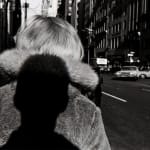Lee Friedlander American, b. 1934
New York City , 1966
Vintage silver gelatin print, mounted on 2-ply archival board. (Printed 1966-1967)
Image - 5.25” x 8.25”
Mount - 11” x 14"
Mount - 11” x 14"
Further images
In the mid-sixties Friedlander economized printing paper by cutting sheets of 11”x14” paper in half to 7”x11”. The typical image size of 60’s prints were 5 5/8”x8 7/16”. By 1965,...
In the mid-sixties Friedlander economized printing paper by cutting sheets of 11”x14” paper in half to 7”x11”. The typical image size of 60’s prints were 5 5/8”x8 7/16”. By 1965, Friedlander had began mounting prints using archival board and settled upon the mount size of 11”x14”. By 1971, he began printing larger and using the full 11’x14” sheet of paper and abandoned the practice of mounting altogether (except for portfolios).
Friedlander’s negative number system was created in 1966/1967, in which this photograph is negative number 29-21. However, this print does not bear any number, which suggests it was made prior to his implementation of writing the negative number on each print.
The stamp on the verso of this print bears no zip code in the address. Zip codes were not created until 1963. It’s evident that Friedlander continued using this stamp however, sans zip code, for a few years after zip codes became required. By 1967/68 Friedlander had changed his stamp to include the zip code of 10956 in his address.
Because of the early printing style, which was more dark and contrasty, and the aforementioned details on the artists mounting style, stamp and negative numbering, this photograph is one of the earliest known prints of “New York City, 1966”, produced around the time of when the negative was created.
Friedlander’s negative number system was created in 1966/1967, in which this photograph is negative number 29-21. However, this print does not bear any number, which suggests it was made prior to his implementation of writing the negative number on each print.
The stamp on the verso of this print bears no zip code in the address. Zip codes were not created until 1963. It’s evident that Friedlander continued using this stamp however, sans zip code, for a few years after zip codes became required. By 1967/68 Friedlander had changed his stamp to include the zip code of 10956 in his address.
Because of the early printing style, which was more dark and contrasty, and the aforementioned details on the artists mounting style, stamp and negative numbering, this photograph is one of the earliest known prints of “New York City, 1966”, produced around the time of when the negative was created.
Provenance
Acquired from Howard Greenberg Gallery, 1990’s1
of
4






